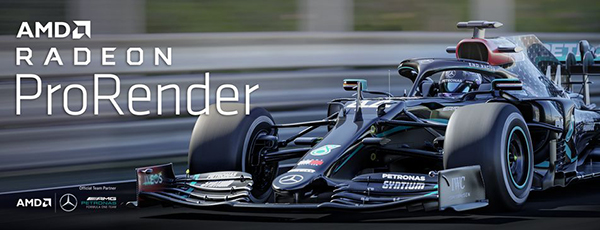AMD Radeon ProRender Developer Updates and Beta Plug-Ins Available
The company has updated the beta of its upcoming Radeon ProRender 2.0 SDK and offers new beta versions of open-source plug-ins for Autodesk Maya, Blender and SideFX Houdini.

AMD Radeon ProRender updates. Image courtesy of AMD.
Latest News
August 23, 2021
AMD Radeon ProRender, available in over a dozen digital content creation and CAD applications, is a fast, easy rendering engine built on industry standards that lets users create photorealistic images on virtually any GPU, any CPU and any OS1, AMD reports.
The company has released some updates for developers including an update to the beta of its upcoming Radeon ProRender 2.0 SDK and new beta versions of open-source plug-ins for Autodesk Maya, Blender and SideFX Houdini.
Updated Radeon ProRender 2.0 SDK Beta for Developers
Back in May, AMD released the first beta of the Radeon ProRender 2.0 SDK, the next generation of its rendering software that is part of the Radeon ProRender Developer Suite, and now it is releasing an updated beta with more new features.
In addition to the features and improvements of Radeon ProRender 2.0, the company is adding three key new additions to the latest beta: MaterialX support, LPE (Light Path Expression) AOVs and sphere and disk light types.
Continued Support for Open Standards with MaterialX
MaterialX is an open standard created by Lucasfilm for the transfer of materials between applications and renderers. It addresses the need for a common standard for the look of 3D assets (including shaders, textures and materials) in content creation workflows that often use multiple applications.
Radeon ProRender 2.0 now supports standard MaterialX nodes, including the “Standard Surface” shader, and by using its updated SDK developers can now easily add support for this industry standard into their application.
Developer Defined AOVs and New Light Types
In the current version of the Radeon ProRender SDK and the plug-ins and application integrations built upon it, we support a wide variety of common AOVs (Arbitrary Output Variables). However, these predefined AOVs don’t always fit an artist’s needs, so in Radeon ProRender 2.0 we’ve added support for LPE (Light Path Expressions) AOVs. This gives developers nearly unlimited options to define AOVs in their application or the ability to let users create their own custom AOVs based on the desired light path.
For even more details on AMD's latest updates, click here.
Sources: Press materials received from the company and additional information gleaned from the company’s website.
More AMD Coverage

Subscribe to our FREE magazine, FREE email newsletters or both!
Latest News
About the Author
DE’s editors contribute news and new product announcements to Digital Engineering.
Press releases may be sent to them via [email protected].






